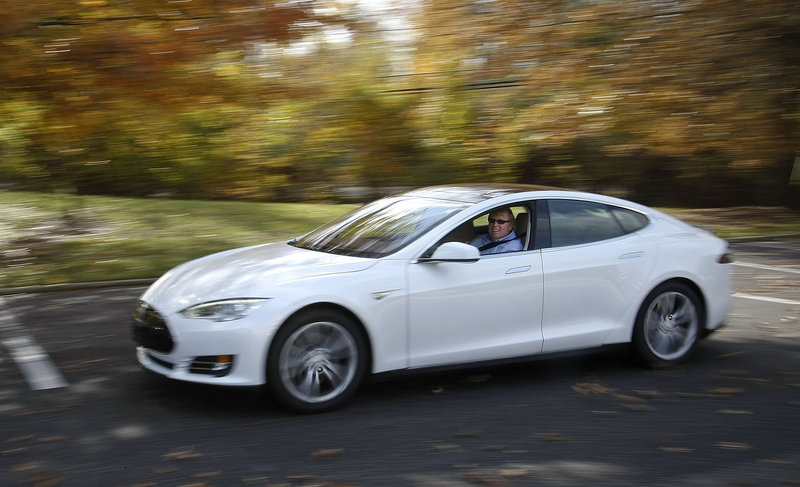Behind the wheel in an empty spot of his Cherry Hill, N.J., law firm’s parking lot, Peter Spirgel grinned wickedly. Then he floored it.
The Tesla sedan — a Model S Performance, for those who attend to such details — shot from a standstill.
Just eight days into ownership, Spirgel was still like a giddy kid, noting the luxury details, the 17-inch screen that governs everything — “like driving an iPad,” a friend said — and, not least, the engineering marvel of a top-end electric car.
When Spirgel took delivery, he became another statistic, albeit a snazzy one, in the growing electric-vehicle marketplace.
Throughout the nation, cars that get their fuel from a plug, not a nozzle, are making inroads.
Two years into electric vehicles being broadly sold to consumers — notably, through the Chevy Volt and the Nissan Leaf — they remain a fraction of the nation’s passenger fleet, due partly to cost.
But nationwide, more than 40,000 plug-in electric vehicles have been sold in the past two years, and in one year, sales tripled.
The vehicles are seen as key to meeting the new fuel-efficiency standards of 54.5 miles per gallon by model year 2025.
Electric vehicles are catching stares in parking lots and thumbs-up on highways. Charging stations are burgeoning, too.
So far, the Volt, which goes 40 miles on a charge before switching to gasoline, is outselling the Nissan Leaf, which is all-electric and gets about 100 miles to a charge.
“I think people are afflicted with range anxiety,” said Tom Saxton, vice president of the advocacy group Plug-In America. He defines it as “the irrational fear of running out of charge” before reaching one’s destination.
But do the math, Saxton said, and you’ll be OK.
The East Coast lags behind the West Coast — partly, researchers say, because there are fewer high-occupancy-vehicle lanes. Restricted to carpoolers and, more recently, hybrid or electric vehicles, they offer a dodge around congested traffic.
And other barriers remain, including familiarity with the technology.
Plus, of course, the cost. Base price for the Leaf is $27,700; for the Volt, it’s $31,600. Both totals are after the $7,500 federal tax credit.
(Charging changes the equation. A charging company executive said that, nationwide, gasoline costs 16 to 18 cents a mile versus 2 to 3 cents a mile for electricity.)
So officials are squeamish about putting public money into a technology that, for now, only the rich can afford. But they are happy to encourage adoption by, say, smoothing out building codes and inspections for charging stations.
Spirgel, CEO of the Flaster/Greenberg law firm, is happy to play the role of early adopter. “Someone has to start this transition. And if people start driving these, the batteries will get better, they’ll get a longer range, they’ll get cheaper.”
He did have the means to buy a model that starts at about $80,000 and has a 300-mile range.
But he didn’t want something that looked like “a granola car.” His kids, now grown, think it’s the first cool car he has ever driven.
Meanwhile, research agencies are in data-collection overdrive.
Data are considered so vital to predicting what might happen that one national firm, ECOtality, gives free household chargers for Leaf and Volt buyers in exchange for data. Its EV Project is a $120 million partnership with the U.S. Department of Energy to gather information on how electric vehicles are being used.
Nationally, researchers have found that when chargers are installed at retail locations, electric-car drivers visit two to three times more often than the outlet’s most loyal customers, and they stay for longer periods.
This could make recharging “part of everyday life,” said ECOtality’s Colin Read.
Other infrastructure is in the works. OnStar, GM’s safety, navigation, and communication arm, is developing apps to help electric-vehicle drivers calculate their range, find charging stations, and tap their phones to a charging device to start the juice.
Of course, electric cars could be overtaken by other technologies.
But after a ride in Spirgel’s Tesla, Frank Riesenburger, chairman of the firm’s environmental practice group, was grinning.
“This is absolutely the future of where automobiles are going to go,” he said. “How long the infrastructure is going to take to build, we don’t know. But it’s here.”
Send questions/comments to the editors.



Success. Please wait for the page to reload. If the page does not reload within 5 seconds, please refresh the page.
Enter your email and password to access comments.
Hi, to comment on stories you must . This profile is in addition to your subscription and website login.
Already have a commenting profile? .
Invalid username/password.
Please check your email to confirm and complete your registration.
Only subscribers are eligible to post comments. Please subscribe or login first for digital access. Here’s why.
Use the form below to reset your password. When you've submitted your account email, we will send an email with a reset code.